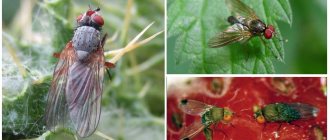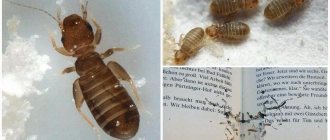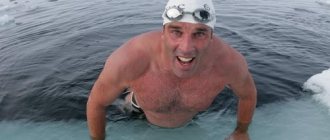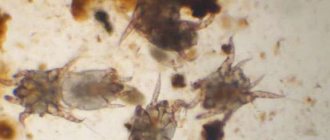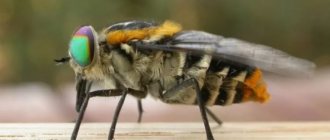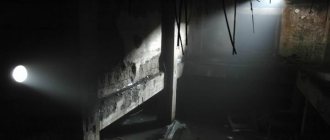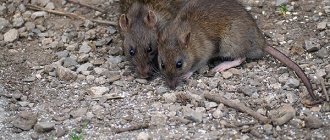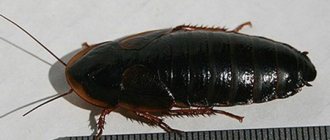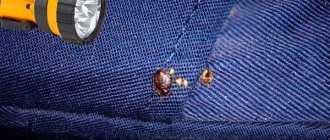Pubic lice infestation. How dangerous are parasites for humans? What do pubic lice look like and how to diagnose an infestation. Symptoms. Development and reproduction of parasites. Effective treatment. The use of specialized drugs and folk remedies. Preventive actions.
As you know, a person can become infected with several types of lice, one of which is pubic lice. This disease is called phthiriosis; it is quite dangerous for human health and requires effective treatment. Next, we will take a closer look at what pubic lice look like, their development and reproduction, causes of infection, symptoms, and effective treatments.
What they look like
This is a small insect with a fairly wide body and a long head, without wings. It is also called ploshitsa. Females are always larger than males, females reach a size of 1.5 mm, males only 1 mm.
The abdomen and chest look fused and there are no clear demarcations. A piercing-sucking mouthpart that has a proboscis. The proboscis has three very sharp stilettos.
The insect needs regular and frequent feeding, this happens as follows:
- The proboscis turns out and the edges are pressed tightly against the skin.
- Using stilettos, the skin is pierced and saliva is released into the wound.
- The esophagus expands and begins to work like a pump.
- After saturation, the proboscis retracts back.
At one time, the flathead can drink 0.1 ml of blood, which is quite a lot for its size. It is quite difficult to detect the parasite, since they have the ability to change the color of the body to match the color of the human skin. As to whether pubic lice are carriers of infectious diseases, this fact has not been proven.
Description of the problem
The favorite places of parasites are the genital areas (perineum, scrotum, pubis), hair growing around the anus, as well as the armpits. Much less often, parasites can be found on eyelashes, in the area of the beard, mustache, and eyebrows. In extremely rare cases, they can live on the head.
These insects feed exclusively on human blood and die within a day without food. This type of parasite is not capable of existing outside the human body. Many people are interested in what pubic lice look like on humans? Outwardly, they are small insects of light brown color. Their length is 1-3 mm, the size of the larvae is no more than 0.7 mm. An interesting feature is the long, spaced legs, which give the impression that the parasite is larger in width than in length. You can see what a pubic louse looks like in the photo.
Due to its light brown color and very small dimensions, it is very difficult to notice an insect on the skin. Diagnosis is also complicated by the general structure of hair in the intimate area.
In general, it is difficult to identify a pubic lice with the naked eye, even if you know the appearance of a pubic lice well and study the photo. It looks like a small seal on the hair, it is practically not noticeable, since it likes to be located at the very root of the hair.
The plate is perfectly adapted to hold on the hair. Its strong legs are equipped with something like claws, and the shape of its body allows it to press tightly against the hair. With such a clumsy body, the insect can move quite quickly, looking for the optimal place to bite.
The larvae of adult individuals are very small in size; in the early stages, the length of the nit is about 0.5 mm. In the photo you can clearly see what a louse larva looks like on the pubic area.
The pubic louse is difficult to confuse with other human parasites, even with the head body louse. After all, only they bite in the intimate area. After looking at photographs under a microscope, you should pay attention to the small dark dots on the hair - this is exactly what parasites look like when you look at them with the human eye.
Development cycle and reproduction process
The female mate throughout her life and lays eggs. They reproduce very quickly and increase their numbers significantly in a short period of time. Favorable conditions for reproduction are constant human body temperature.
In one day, the female lays about 3 eggs; they are pear-shaped and their size ranges from 0.65 to 0.67 mm. When laying eggs, the female secretes a special adhesive substance, thanks to which the nit is securely attached to the hair.
One nit is deposited on one hair. Nits, as well as insects in the imago stage, are highly viable. They can withstand temperatures up to 50° for half an hour. In addition, they can easily tolerate such a caustic and aggressive substance as kerosene within 10 minutes.
It takes 4 to 8 days for nits to develop. Next comes the larval stage, which lasts from 10 to 12 days. During this time, the individual goes through 3 moults and transforms into the imago stage; this is a young individual capable of mating and reproducing. The female lives only 2 weeks. Pubic lice breed throughout the year, but peak numbers occur from September through November and February.
Prevention measures
To prevent the risk of developing a disease such as lice pubis, a number of rules should be followed. They are to:
- carefully observe personal hygiene standards,
- do not use other people's clothes, underwear,
- iron all things,
- shave off pubic hair,
- avoid sleeping on beds in dubious hotels,
- wash your underwear and bed linen regularly,
- limit sexual contacts with unfamiliar partners.
Pubic lice are parasites that attach to hairs growing in the intimate areas. The flats cause severe itching, burning, and can cause inflammation. They need to be dealt with comprehensively: using medications to treat the affected areas, but neglecting personal hygiene standards, it is impossible to get rid of pubic lice.
Signs of infection
If we talk about the main signs of infection, it is certainly worth noting the severe itching that occurs due to an insect bite. But each person reacts differently.
Let's take a closer look at the symptoms:
- In the pubic area, perineum, on the inner surfaces of the thighs, lower abdomen, armpits, scrotum, anus, the presence of adult individuals and nits is observed. They can also be observed on the beard, eyebrows and eyelashes. If the infection occurs in a child, they can be located behind the ears, on the back of the head, or eyelashes.
- Allergic reactions, which most often manifest themselves in the form of itching.
- Round spots of a bluish tint appear, which have a red dot in the center, the diameter of the spot is about 1 cm. These spots can be observed on the thighs, abdomen, and groin; they are a consequence of the bite and go away on their own in 1-2 weeks.
- If treatment is not undertaken, diseases such as eczema and dermatitis develop.
- Constant itching leads to severe scratching, where coccal microflora develops, which leads to secondary pyoderma.
The disease has an incubation period, since the main symptom is itching; it can take about 30 days before it appears from the moment of infection.
Symptoms of infection
Symptoms of phthiriasis are expressed as follows:
- itching of the skin,
- local thickenings on the skin,
- papules and blisters forming in the affected areas,
- inflammatory processes on the skin caused by scratching the affected areas,
- burning in the areas of the anus and external genitalia,
- red or blue spots that quickly disappear and occur as a result of secretion deposits or blood sucking,
- scratching in affected areas,
- the appearance of brown particles,
- inflammatory processes associated with the addition of a secondary infection that penetrates through scratched skin,
- dark brown-orange spots on underwear, which are waste products of parasites, as well as lice and larvae on it.
Signs of lice pubis are no different in men and women.
Methods of infection
There are predisposing factors that significantly increase the risk of infection, these include large crowds of people, unsatisfactory sanitary and living conditions. It is also worth noting that in cold weather the risk of infection increases.
Routes of infection may be as follows:
- Domestic. Infection can occur due to the use of infected clothing, bedding, and toilet seats.
- Intimacy.
- When using general beard and mustache brushes, applies to men.
Routes of infection by flatweed
Infestation with pubic lice is considered a sexually transmitted disease and is called phthiriasis or pediculosis pubis. Both men and women can become infected with it. Among the main routes of infection are:
- Intimacy with different partners, promiscuity.
- Other people's hygiene products: towels, bed and underwear, combs, washcloths.
- Public areas: baths, saunas, swimming pools, public toilets, gyms, etc.
- Mass gatherings of people in places with a lack of proper hygiene: barracks, dormitories.
Diagnosis of the disease
For an accurate diagnosis, a parasitological examination is required, as well as a general assessment of the clinical picture. During the examination, a slit lamp is used, which makes it possible to conduct diagnostics on the eyelashes and eyebrows.
In men, an examination is carried out in the genital area, abdomen, back, and chest. In women and children, these areas are also examined, but in this case, vellus hair.
Detection methods include:
- The use of a Wood's lamp, thanks to which nits can be identified; if they are present, a pearl-white glow appears.
- A white sheet of paper is used, onto which insects are combed out using a fine comb.
- Visual inspection makes it possible to detect parasite eggs; both living and dead, empty egg shells can be observed.
- Also, visual inspection makes it possible to detect adult individuals.
For visual inspection, a magnifying glass or microscope is used.
Diagnosis can also be carried out using modern technology - a videoscopic digital system. It consists of a small specialized video camera that is connected to a computer.
During inspection, the camera captures the insects, enlarges them several times, and the image is displayed on the screen. The computer saves the image and analyzes it. This makes it possible to quickly diagnose and prescribe effective treatment to the patient.
Symptoms and signs of pubic lice
Despite its name, this type of lice is not always found on the pubic area. Ectoparasites can “settle” not only in the genital area, but also in other areas: abdomen, chest, armpits, navel, thighs, eyelashes, eyebrows. In men, lice may also appear on the beard or mustache, this is especially possible in the case of increased body hair.
Phthiriasis does not have many symptoms. The first and most basic is itching in the areas where lice are located. For some people it is unbearable, but for others it causes only minor discomfort. This is due to the fact that during an ectoparasite bite, saliva enters the human bloodstream. Itching is a reaction to this saliva. It should be noted that the itching caused by flats increases at night.
In addition to this, other symptoms are also observed:
- grayish-blue spots on the skin;
- white small dots in the hair, indicating the presence of lice eggs;
- the appearance of dark brown spots on underwear;
- scratching.
Often, severe itching leads to a person scratching the skin vigorously, resulting in redness, irritation, eczema, and an increased risk of infection. The affected areas may harden and become rough and flaky.
Small spots may appear as a result of minute hemorrhages when ectoparasites suck blood. The spots are no more than 1 cm in size and disappear quickly. The bluish color is caused by the destruction of hemoglobin, which occurs due to the saliva of parasites.
In some cases, patients experience an allergic rash, and in advanced forms, blisters may form on the affected areas of the skin, and the itching increases.
If lice have settled on your eyelashes, you should be aware that their presence can lead to blepharitis.
Also, all of the above symptoms are often accompanied by tangled hair at the location of the flats and the formation of so-called “tangles”. This is due to the fact that females, when laying eggs, secrete a sticky substance that allows them to firmly attach to the roots of the hair.
How to remove parasites
Treatment is aimed at eliminating the parasites, namely, it is necessary to completely get rid of the parasites, regardless of the stage of development. Effective treatment is an integrated approach that uses mechanical, physical and chemical methods.
Nowadays you can buy specialized preparations in the pharmacy in the form of shampoos, aerosols, soaps, lotions, and emulsions. The composition includes pyrethroids or permethrins, which act as insecticides and are of natural origin. As a rule, the mechanism of action and method of use of drugs are similar to each other.
But it should be noted that each medicine has its own contraindications. The choice should be made based on individual indications. Be sure to study the instructions for use and follow them strictly.
Before using the drug, you must shave the hair in the pubic area and under the arms. After 7-10 days, the treatment is repeated to avoid re-infection, which can occur due to remaining nits on the body. Let's look at the most popular drugs that have proven their effectiveness.
Nittifor
Available in the form of a colorless solution, which is made on a water-alcohol basis. You can buy it in 60 ml bottles. The main active substance is permethrin, which provides increased insecticidal effect.
The solution is applied to the affected areas, left for 40 minutes, after which it is thoroughly washed off with water. Re-treatment after 7 days is recommended.
Pedilina
You can purchase it in the form of an emulsion. The main active substance is tetramethrin, as well as malathion in the shampoo. The first component is a synthetic poison, the second is an organophosphate insecticide.
It should be applied as follows: in case of severe damage, an emulsion is applied, which must be left for 30 minutes. Then the emulsion is washed off with water and shampoo is applied for 3 minutes, then take a shower and rinse thoroughly with water.
If the lesion is not severe, it is recommended to use shampoo. It should be applied with massaging movements, rubbing. Leave for 5 minutes and rinse thoroughly with water. Remember that the drug is toxic and should be used with extreme caution.
If you inhale insecticide vapors for a long time, side effects may develop, which manifest themselves in the form of tachycardia, increased sweating, nausea, vomiting, and intestinal colic.
If side effects occur during the procedure, you should immediately wash off the drug and go to the hospital. For this poisoning, diazepam and atropine are prescribed.
Paranit
The product contains silicone oils. The effect of the substance is as follows: upon contact, they affect the nervous system, causing paralysis and subsequently death.
You can buy it in the form of shampoo, spray and lotion. It has a great advantage, since in one treatment it destroys 97-100% of nits and adults. Can be used by pregnant women and children over 3 years of age.
Knicks
A very popular product that can be purchased in the form of a cream. The main active ingredient is 1% permethrin. It should be applied to the skin with massaging movements, leave for 10 minutes and then rinse thoroughly. Ensures the destruction of adults, larvae and nits. Can be used by children from the age of 2 years.
Veda
You can buy it in the form of shampoo. The main active ingredient is permethrin (0.5%). When applying, you need to rub it a little into the skin, leave for 10 minutes and rinse thoroughly. Ensures the destruction of parasites at all stages of development.
Boric ointment
The active substance is 5% boric acid. This substance has not only a pediculicidal effect, but also antibacterial, astringent and fungistatic. Apply to the affected area and leave for half an hour, after which it is washed off well with soap and water.
It has its own contraindications; it should not be used by pregnant and lactating women, people who have kidney disease and children at an early age.
Medifox
It is used to treat bedding and clothing. You can purchase it in the form of a concentrated emulsion. The active ingredient is permethrin. Before use, you should prepare a solution; for this you need to dilute 20 g of emulsion in 960 ml of water.
It is necessary to soak the items to be treated in the solution for 40 minutes. Next, the items are rinsed in clean water and soaked in saline solution for 1 day. To prepare a saline solution, you need to dilute 1 tbsp in 1 liter of water. salt. Then things are washed.
Traditional methods
Many people turn to folk methods of struggle for help. If we talk about the most popular and effective, it is worth noting soap-kerosene emulsion. It can be used to treat affected areas of the skin, and can also be used to treat bedding and things.
To prepare the emulsion, you will need to mix 200 ml of kerosene, 100 g of laundry soap and 1 liter of warm water. Mix thoroughly until the soap is completely dissolved. Before treating the skin, this emulsion is also diluted with 100 ml of emulsion per 1 liter of water. Apply for 1 hour, then wash off with warm water. After 2 days, the procedure is repeated.
Hellebore water is also very popular. You should purchase an alcohol tincture, then dilute it with water in a 1:1 ratio. The solution is prepared before treatment, applied for 30 minutes, then washed off with warm water. But remember that you will need to carry out more than one treatment; in one procedure, from 35 to 50% of insects die.
To treat eyelashes, you can use Vaseline, which is applied 2 times a day for a week. Vaseline can be replaced with 2% yellow mercury ointment.
Folk remedies
You can remove pubic lice at home using folk remedies:
Kerosene. This remedy has been used to get rid of lice since time immemorial. But the skin on the pubic and genital area is very sensitive, so kerosene must be mixed with vegetable oil in equal proportions to avoid getting burned . The product is applied to the affected area and left for 6-8 hours, then washed off with warm water. After 10 days, the procedure is repeated.- Vinegar. To do this, 9% vinegar is diluted with water in a ratio of 1:3. Dilute vinegar is applied to the groin area and washed off after an hour. The procedure must be carried out within 3 days.
- A mixture of sorrel and garlic . Mix sorrel juice with chopped garlic in a ratio of 1:3. The mixture is applied to the lice-affected area for 10 days.
- Mint and lemon. The juice of 1 lemon is combined with the same amount of vegetable oil and 2 tablespoons of mint leaves. All ingredients are mixed and applied to the skin daily for 2 hours. The procedure is carried out for 10 days in a row.
Consequences after the disease
In addition to the fact that these parasites bring great discomfort and inconvenience to a person, there is a risk of developing pustular lesions. Itching leads to scratching of the skin, and infection and pyogenic microbes get into these wounds.
If the affected area is the eyelashes, an inflamed red streak appears on the upper eyelid, and conjunctivitis may also develop. Statistics show that 65% of those infected have scabies, and 35% have concomitant sexually transmitted diseases.
Lice themselves do not cause infectious diseases and do not transmit them, but their parasitic lifestyle and wounds on the skin from scratching are ideal conditions for the spread of infections. If treatment does not occur, eczema, boils, and abscesses often develop. Blepharitis forms on the eyelids and the mucous membranes become inflamed.
Only the correct treatment, which a specialist has selected for the patient, taking into account individual indications, can get rid of parasites and prevent the development of complications.
